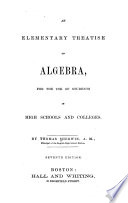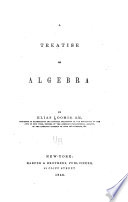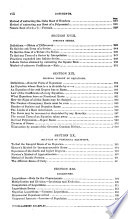 | Silas Totten - Algebra - 1836 - 332 pages
...product of this last term of the root by those which precede it, and the square of this last term. Multiply the divisor, thus increased, by the last term of the root, and subtract the product, and to the remainder bring down the next three terms, and proceed in the same manner, till all the... | |
 | Thomas Sherwin - Algebra - 1841 - 320 pages
...term of the root, also at the right of the divisor. Multiply the divisor, with the term last annexed, by the last term of the root, and subtract the product from the last dividend. 5. The remainder will form a new dividend, with which proceed as before ; and thus continue,... | |
 | Elias Loomis - Algebra - 1846 - 380 pages
...adding to it three times the product of the two terms of the root, and the square of the second term. Multiply the divisor thus increased by the last term...manner to find the additional terms of the root. Ex. 1. Extract the cube root of a3+ 12a' + 4Sa + 64. a3 + 12a2 + 48a + 64 | a + 4 = the root. a3 12a" + 4Sa... | |
 | Elias Loomis - Algebra - 1846 - 376 pages
...terms of the, root, and the square of the second term. Multiply the divisor thus increased by the-last term of the root, and subtract the product from the...manner to find the additional terms of the root. Ex. 1. Extract the cube root of a3+ 12a2 + 4Sa + 64. a3 + 12a2 + 4,8a + 64 a + 4 = the root. 3а* + 12a +... | |
 | Joseph Ray - Algebra - 1848 - 250 pages
...the divisor, the result will be the second term of the quotient. Multiply the divisor by this term, and subtract the product from the last remainder. Proceed in the same manner, and if you obtain 0 for a remainder, the division is said to be exact. REMARK s. — 1st. It is not... | |
 | Joseph Ray - Algebra - 1848 - 252 pages
...result both to the root and the partial divisor. Multiply the divisor thus increased, by the third term of the root, and subtract the product from the last remainder. Then proceed iu a similar manner, to find the other terms. II E ss A u K. — In the course of the... | |
 | Joseph Ray - Algebra - 1848 - 250 pages
...result both to the root and the partial divisor. Multiply the divisor thus increased, by the third term of the root, and subtract the product from the last remainder. Then proceed in a similar manner, to find the other terms. R z MAR K. — In the course of the operations... | |
 | Joseph Ray - Algebra - 1852 - 408 pages
...the first and second terms by the third, plus the square of the third. Multiply these by the third term of the root and subtract the product from the last remainder. 4th. Continue this process till all the terms of the root are found. NOTE. — The remainder in each... | |
 | Elias Loomis - Algebra - 1855 - 356 pages
...adding to it three times the product of the two terms of the root, and the square of the second term. Multiply the divisor thus increased by the last term...manner to find the additional terms of the root. Ex. 1. Extract the cube root of a'+12a'+48a+64. a°+12a'+48a+64 | a+4 = the root. 12a'+48a + 64 12a'+48a+64... | |
 | Thomas Sherwin - Algebra - 1855 - 262 pages
...term of the root, also at the right of the divisor. Multiply the divisor, with the term last annexed, by the last term of the root, and subtract the product from the last dividend. 5. The remainder will form a new dividend, with which proceed as before ; and thus continue,... | |
| |